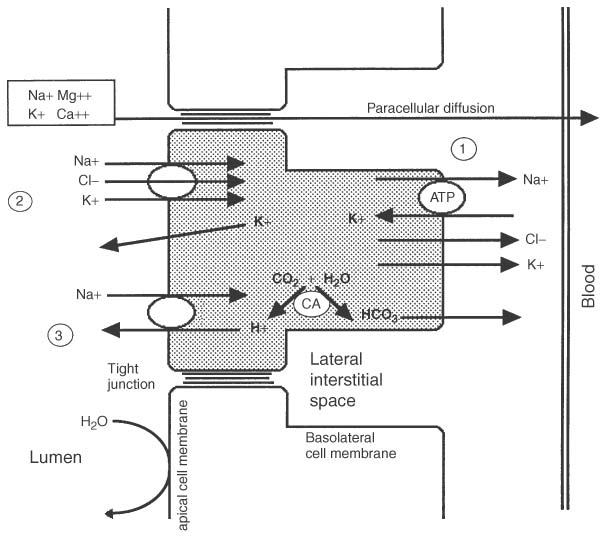 |
 |
Figure 20-7
Mechanisms of tubular secretion and reabsorption. This
tubular cell in the thick ascending loop of Henle encompasses the major mechanisms
of secretion and reabsorption, one or more of which is used by various segments of
the tubule. The most ubiquitous and important transport mechanism is the energy-requiring
Na-K-ATPase pump in the basolateral cell membrane (1), which pumps sodium out into
the interstitium against its concentration gradient and maintains a low intracellular
concentration. This mechanism favors inward movement of sodium from the tubular
lumen, facilitated by a sodium chloride symporter system on the apical cell membrane
(2), which creates enough potential energy to draw in potassium against its concentration
gradient and is the primary inhibitory site of action of loop diuretics. A sodium-H+
antiporter system on the apical cell membrane (3) aids sodium reabsorption and extrudes
H+
, thereby promoting the reaction of water with carbon dioxide to form
H+
and bicarbonate ion under the influence of carbonic anhydrase (CA).
Bicarbonate diffuses out into the capillary. Sodium reabsorption is thereby coupled
to H+
loss and bicarbonate reabsorption. The transport proteins create
a positive charge in the lumen, which drives ions such as sodium, calcium, potassium,
and magnesium passively through the tight junctions by paracellular diffusion. The
thick ascending loop of Henle is uniquely highly water impermeable, so luminal osmolality
progressively falls to less than 150 mOsm/kg (the "diluting segment"). (Modified
from Stanton BA, Koeppen BM: Elements of renal function. In
Berne RM, Levy MN [eds]: Physiology, 4th ed. St Louis, CV Mosby, 1998, pp 677–698.)

 |
